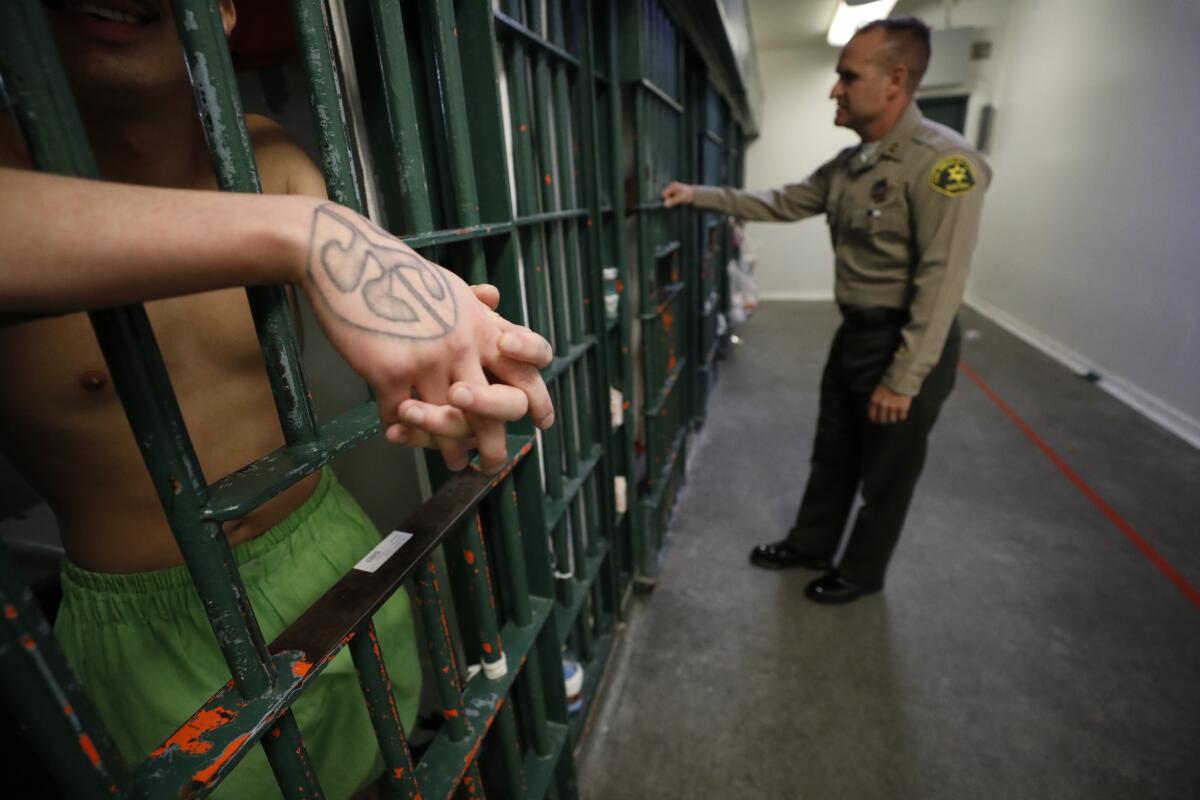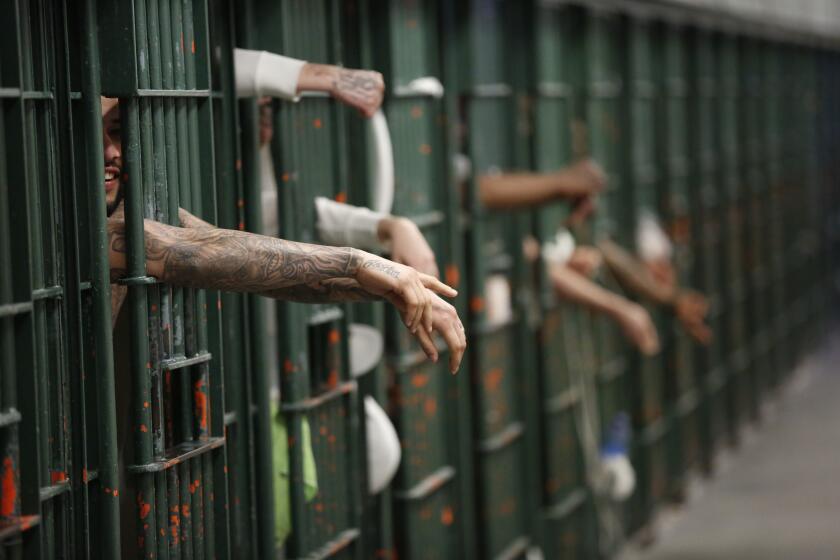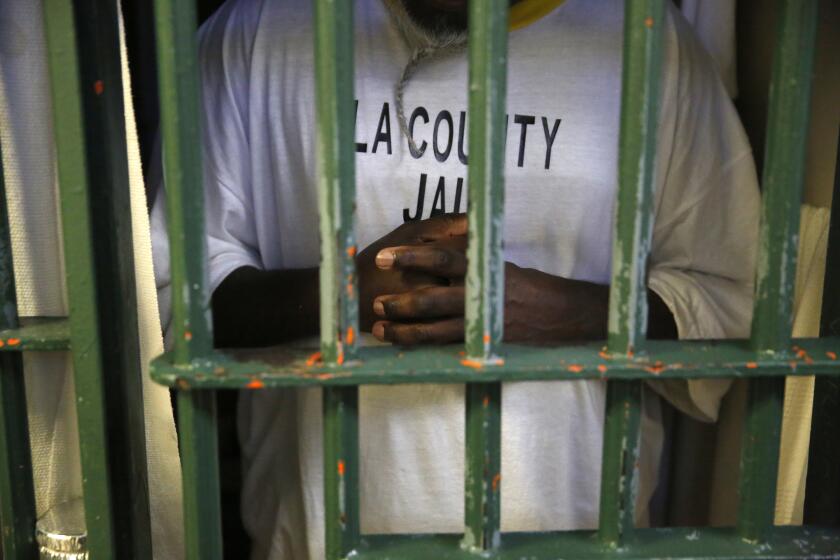Editorial: Why is L.A.’s cruel and deadly jail still open on shutdown date?

This is the day Los Angeles County’s dungeon was supposed to close.
But Men’s Central Jail appears to be no nearer to shutting down than it was on March 30, 2021, when county officials appointed by the Board of Supervisors presented a two-year timeline to get people out of the dangerous building, now 60 years old, and begin tearing it down.
Failure to meet the schedule is an affront to human decency and a discredit to the supervisors and the sheriff, who ultimately are responsible for the jail and the tragedy that unfolds inside on a daily basis.
The notorious jail is among the nation’s cruelest. Its 1963 design is shockingly outmoded, preventing deputies from seeing inside cells without first walking the corridors and becoming targets for the human waste thrown at them by the occupants, a large portion of whom suffer from mental illness and receive insufficient care and attention while they await court hearings or transfer to medical facilities.
Los Angeles County’s progress in rolling back needless incarceration and building up a care-based response to public safety has been extraordinary. Now is the best time to proceed: Start the jail demolition countdown.
There is a dearth of functioning equipment to meet basic health and sanitation needs, and too little opportunity for exercise, contributing to physical and mental decline. Like the county’s Inmate Reception Center — a newer adjacent facility in the massive jail complex on the north end of downtown Los Angeles — Men’s Central Jail is plagued by deaths, including three in the last two weeks. None of the three deceased men had been sentenced.
The jail has operated under court oversight since 1978 due to health and safety problems but continues to be the subject of new lawsuits for continuing failures. The supervisors lost precious time over the last 20 years debating how many people they should be able to lock up in a replacement facility and finally agreed — correctly — not to build a new jail at all. Instead they supported providing more humane and effective custody or diversion focused on mental health and substance use disorder treatment with a goal of stemming the return flow of former jail occupants back to incarceration, or into hospitalization or life on the streets.
In the meantime, though, despite creating an implementation team to meet the two-year timeline, Men’s Central Jail is still here and, for all practical purposes, still full.
The 2021 closure plan centered on reaching a population target for an entire county jail system that in the past has exceeded 19,000. If the number can be brought to fewer than 8,500, there would be enough capacity throughout the rest of the system to absorb Men’s Central Jail occupants and it could safely close.
The money bail system betrays a host of fundamental American values, including the presumption of innocence, the right to counsel and equality in the eyes of the law.
For a short time the county was on target, due to efforts to stem the spread of COVID-19 inside the jails. Courts limited the pretrial population — people who were arrested and either awaiting trial, release on bail or a plea bargain — by resetting bail at $0 for people accused of nonviolent and less serious crimes. By mid-2020, the jail system’s population dropped below its rated capacity of 12,404 for the first time in years. The 8,500 target was within reach.
But money bail for most people accused of crimes returned last year, and the jail population last week was back up to nearly 14,000.
The largest segment of those occupants that can be safely reduced is pretrial. The county must work harder to keep people out of jail who are there only because they are too poor to pay bail. Officials have taken too long to create a comprehensive, functioning pretrial services system that ensures people charged with crimes come to court on their appointed dates and, in the interim, provides the treatment and oversight to protect their neighbors and themselves. The county has to recommit itself to that work and step up the pace. It should stop fighting a challenge to the bail schedule — the subject of an ongoing hearing that is due to return to court on Tuesday.
To understand the consequences of continuing failure, one need only look at the county’s juvenile justice facilities, where conditions have become so abysmal that state officials are likely to close them and force the county to find alternative accommodations for nearly 400 offenders.
Men’s Central Jail, the Inmate Reception Center and other parts of the adult jail system are under similar scrutiny because of deadly conditions. As with federal court orders to reduce the state prison population more than a decade ago, the county has a choice: Select the people to release and where they will be housed and supervised instead, or allow the courts to release people without alternative housing and deal with the consequences for public safety.
Men’s Central Jail will close — either because the county closes it after securing alternative placements for thousands of people who don’t need to be there, or because a court orders it to shut to protect life and safety.
More to Read
A cure for the common opinion
Get thought-provoking perspectives with our weekly newsletter.
You may occasionally receive promotional content from the Los Angeles Times.












